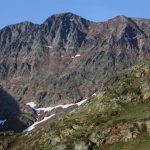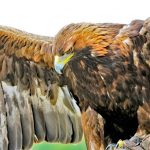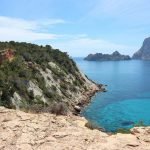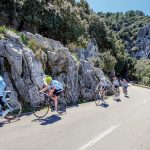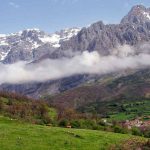Madrid, wildlife city
While Madrid for many is simply the city, its nightlife, bars, tapas and museums, it can probably boast claims of being the best capital for birdwatching in Europe. Admittedly you have to include some of the outskirts to accept the presence of some of the rarer species and also other wildlife, but in what other city can you take a bus to see such globally rare species as Spanish Imperial Eagle, Eurasian Black Vulture or Great Bustard?! Some excellent birds can be found within the city’s parks too and this is just a brief overview of some of the birds present in the area and where to see them.
The main places are clearly going to be the open ‘wild’ spaces, i.e. the parks, and above all, the ‘three green lungs’ of Madrid – El Pardo (not to be confused with the museum of El Prado) to the NW, Casa de Campo to the W and El (Buen) Retiro in the centre. That said, the Parque Oeste (adjacent to Moncloa bus and metro stations) is also varied (being an arboretum), almost forming a continuum with the Casa de Campo and drops down to the Río Manzanares, a natural corridor for migrants moving through the city.
Starting in the centre, El Retiro (easily reached by metro or bus) is rather busy and noisy, but still supports a few interesting species, especially on migration. While the often melanistic (black) Red Squirrels are a delight, and tamer here than anywhere else, Green Woodpeckers, Spotless Starlings and Tree Sparrows are quite common, Firecrest is frequent and passage species include abundant Pied Flycatchers in autumn and chances of Bonelli’s and Subalpine Warblers especially in spring. House Martins and Common Swifts zoom overhead from spring to autumn.
The Casa de Campo is also readily reached, either via the Metro at the ‘Lago’, ‘Batan’ or ‘Casa de Campo’ stops, or on the bus (e.g. to the zoo), on the ‘teleférico’ cable car ride, or even on foot via the Parque Oeste (though it can be complicated to cross the M30 and river easily). This is a large park (try to orientate yourself a bit with a map to avoid getting lost!), previously unfortunately renowned for the large number of prostitutes working there. However, after major restrictions to vehicle access, this appears to have diminished considerably and walking about with binoculars is now less potentially problematic, though caution is still urged! Near the zoo and down near the lake (Lago), one of the most noticeable species is the exotic Monk Parakeet, a raucous flashy species with a faintly barred pale grey throat which builds huge stick nests on the trees. These are also spreading to other areas, making finding the much scarcer and longer-tailed Ring-necked Parakeet tricky to find!
Native species of interest are clearly present in the Casa de Campo also, ranging from Cormorants, Black-headed and Lesser Black-backed Gulls and the very occasional wild duck on the lake in winter, through resident Red-legged Partridge, Wood Pigeon, Stock Dove, Hoopoe, the Iberian race of Green Woodpecker, plus Great and rarely Lesser Spotted Woodpeckers, Sardinian Warbler, Crested Tit, Short-toed Treecreeper, Tree Sparrow, Spotless Starling, Jay, Magpie and Jackdaw. Spring sees arrival of a few White Storks and passage of a few Cetti’s, Bonelli’s, Subalpine, Orphean (rare) and Melodious Warblers and Nightingale, with some of these staying to breed, and autumn passage again finds Pied Flycatchers in abundance and the odd Common Redstart and Firecrest to vary things. Winter may find a few Grey Wagtails, Dartford Warblers, Firecrest and Black Redstart amongst others, while the ‘end’ of winter (c. mid-February) is often marked by the appearance of a few large flocks of Cranes on their migration N. Listen for their trumpeting calls if visiting around this time and you may be lucky!
A few mammals and other species of note are also present, including Red Squirrels and Iberian Hares (not uncommon), while butterflies include the impressive two-tailed Pasha (rare; waiting around any Strawberry Trees may be the only chance), Large Tortoiseshell and various southern hairstreaks amongst many others.
The Parque Oeste lies almost beside the Moncloa interchange and drops down a little gulley towards the river. Given the mature trees, it’s also home to Stock Dove and Hawfinch (but the earlier in the day the better!), and if it’s really hot, try to find the little pool (“charca”) with its hide and ‘dodgy ducks’ -to the right of the gulley as you drop down it- , but where lots of local birds come to drink.
The jewel in the crown is undoubtedly El Pardo though, accessible via the village of the same name to the NW of Moncloa (to/from where there’s a regular 601 bus). Taking the bus to the last stop at Mingorrubio leaves you on the roadside a little below a dam (of the El Pardo reservoir). Unfortunately, or fortunately in fact for the wildlife (!), most of the park is strictly inaccessible, and you are restricted to the public (non-fenced) areas either side of this almost linear road. Walking past the football pitches you pass through a rough car park and then reach the river, with dehesa (holm oak woodland beyond). Scanning from here can be excellent. I’ve personally seen Spanish Imperial and Booted Eagles, Griffon and Black Vultures, Black and Red Kites, Common Buzzard, Goshawk, Sparrowhawk, Kestrel, Peregrine and Hobby from here, with birds moving up and down the valley including little flocks of Stock Dove year-round and lots of gulls moving to and from the bathing and roosting area on the reservoir, especially in the evenings. One visiting birder even had 40+ Black Terns go over one May!
The river needs close attention too, with Kingfisher regular, Cetti’s Warbler resident and occasional Penduline Tit and Red Avadavat (latter rare). Many passerines in autumn also use this as a migration corridor since the water provides more greenery and cover. It is also possible to cross the river using a narrow footbridge just downstream and then walk down to El Pardo village along the whole of the much quieter opposite bank. This gives more chance of these species, and also Little Bittern and Reed and Great Reed Warblers which breed in the reedmace further down, plus a few other others associated with the bankside trees and adjacent dehesa, including Little Owl, Green and Great Spotted woodpeckers, Hoopoe, Blackcap, Subalpine Warbler and Short-toed Treecreeper amongst others! The areas of poplars attract breeding Golden Orioles and the little arboretum near El Pardo a few Hawfinch if there are seeds on the trees.
It is best to cross over on the road bridge into the town, then if time permits, walk further downstream along this bank. Open areas might produce Zitting Cisticolas and the pines Crested Tit, though there is usually more disturbance and fewer birds. Finally, after passing behind the tennis courts and coming out through the Restaurante La Perdiz car park, a road runs opposite into dehesa and pines, which can be good for birds too. The bus can then be caught back from in front of the restaurant.
Given the complete lack of disturbance from the public in most of the park, the range of species, especially larger species more sensitive to disturbance is unusually high. Mammals are also tamer than normal and Red Deer and Wild Boar are common, and frequently seen from the cercanias train which runs through the park. There also used to be a Spanish Imperial Eagle’s nest on a pylon beside the railway line, often with attendant adult, visible here as you passed through! I’ve also seen the deer and boar by scanning the dehesa on the other side of the river from the football pitches, where I’ve also seen a few Iberian Azure-winged Magpies and Bee-eaters regularly too. As the whole area is generally quiet, Red-necked Nightjar and Eagle, Scops and Long-eared Owls have all been recorded! If you’re really lucky, and get the timing right in spring, a fine display of Wild Paeonies can also been seen in the park, just the other side of the fence as you walk down from the footbridge, i.e. just out of the public’s grasp! The mass flowering of Gum Cistus, abundant on slopes SE of El Pardo is also a fine sight, and a great place to look for Dartford Warblers too!
Finally a small word of advice. In some respects Madrid is like almost any other big capital, and wandering around (especially alone) in remoter areas of parks with lots of expensive optical gear is, in my opinion, not a clever thing to do. Take sensible precautions and you should be fine.
Oh, and what about the bustard? Well, it’ll be explained in full in a forthcoming book to the area that I’m co-authoring at present..

